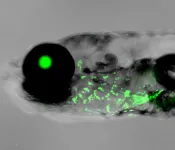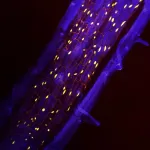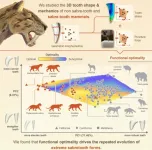(Press-News.org) A study of more than 400 Asian, Black and Hispanic women who had recently given birth found that racism through microaggressions may be linked to higher blood pressure during the period after their baby was born, according to a new study by Columbia University Mailman School of Public Health. More than one-third of the mothers reported experiencing at least one microaggression related to being a woman of color during or after their pregnancy. The research conducted with colleagues at the University of Pennsylvania noted that these types of gendered racial microaggressions suggest blood pressure monitoring and/or treatment for high blood pressure may need to be continued for a longer time after birth. The findings are published in the journal Hypertension, the peer-reviewed journal of the American Heart Association.
“We found that the link between gendered racial microaggressions and postpartum blood pressure was strongest 10 or more days after delivery, during the period after a baby is born when the mother’s blood pressure is monitored less often,” said Teresa Janevic, PhD, associate professor of Epidemiology at Columbia Mailman School and first author. “It is well-known that Black, Hispanic and South Asian women experience microaggressions during health care. It is not as well known how these microaggressions may ‘get under the skin’ to influence their blood pressure,” said Janevic.
In the first year following childbirth, women have an increased risk of developing high blood pressure, which can sometimes be life-threatening and may be associated with developing heart disease later in life. This is especially true in people that had any pregnancy-related high blood pressure issue such as preeclampsia. Previous research has found that Black, Hispanic and South Asian women are at a higher risk of developing heart disease later in life with much of that risk being linked to hypertension.
While previous research has also established links between high blood pressure and racial discrimination, the potential connection between high blood pressure and racial microaggressions — subtle unintentional slights, such as being told to calm down — experienced by pregnant and postpartum women while receiving health care services during pregnancy and delivery needs to be explored, according to the authors.
The study included 373 patients who delivered live babies at four maternity hospitals located in Philadelphia and Queens, New York, between March and October 2022. Study participants ranged from 16 to 46 years old; approximately 43 percent were 20-29 years old; 40 percent of participants self-identified as Hispanic; 39 percent as Black; 10 percent as Asian; and 11 percent selected “other.
Researchers used the Gendered Racial Microaggressions Scale (GRMS), adapted for the obstetric care setting into a 9-item, one-factor scale, to ask women located in four hospitals in Philadelphia and New York City how frequently they experienced gendered racial microaggressions. The women were asked to check their blood pressure at home for three months after birth using text-based monitoring. Researchers also estimated the racism experienced by communities with the Structural Racism Effect Index, a publicly available national index.
The survey asked patients to report how frequently they experienced gendered racial microaggressions (0 = never to 5= once a week or more). Participants were given validated blood pressure monitors and asked through text messaging to record their blood pressure twice a day for the first 10 days after delivery and then twice a week after for the next three months.
The analysis found:
More than one-third of participants reported experiencing at least one gendered racial microaggression during their obstetrical care.
The highest three-month average blood pressures came from participants who experienced microaggressions and lived in areas with high levels of structural racism, while the lowest average blood pressures were observed in participants who lived in areas with low levels of structural racism and who didn’t report experiencing microaggressions.
“It’s surprising the associations were strongest in the later postpartum period between 12 days and three months after delivery. This is an emerging critical period for preventing high blood pressure,” Janevic said. “Our findings provide further evidence that health care professionals and policies should focus more intensely on improving maternal health care equity. We need high blood pressure monitoring and interventions to extend further into the period after birth when blood pressure may continue to be sensitive to social drivers of health.”
Future research is needed to explore how experiencing racism influences blood pressure, to understand the potential health effects on infants and to identify the best interventions to improve postpartum health, Janevic noted.
Co-authors, disclosures and funding sources are listed in the manuscript.
END
Rise in post-birth blood pressure in Asian, Black, and Hispanic women linked to microaggressions
Associations between blood pressure and unintentional discrimination are highest in the later postpartum period
2025-01-09
ELSE PRESS RELEASES FROM THIS DATE:
Weight changes and heart failure risk after breast cancer development
2025-01-09
About The Study: In this nationwide cohort study in the Republic of Korea, postdiagnosis weight gain was associated with an increased risk of heart failure after breast cancer development, with risk escalating alongside greater weight gain. The findings underscore the importance of effective weight intervention in the oncological care of patients with breast cancer, particularly within the first few years after diagnosis, to protect cardiovascular health.
Corresponding Author: To contact the corresponding author, Dong Wook Shin, MD, DrPH, MBA, email dwshin@skku.edu.
To access the embargoed study: Visit our For The Media website at this ...
Changes in patient care experience after private equity acquisition of US hospitals
2025-01-09
About The Study: This study found that patient care experience worsened after private equity acquisition of hospitals. These findings raise concern about the implications of private equity acquisitions on patient care experience at U.S. hospitals.
Corresponding Author: To contact the corresponding author, Rishi K. Wadhera, MD, MPP, MPhil, email rwadhera@bidmc.harvard.edu.
To access the embargoed study: Visit our For The Media website at this link https://media.jamanetwork.com/
(doi:10.1001/jama.2024.23450)
Editor’s Note: Please see the article for additional information, including other authors, author contributions and affiliations, ...
COVID-19 vaccine hesitancy among Black women in the US
2025-01-09
About The Study: The results of this study suggest that addressing COVID-19 vaccine hesitancy among Black women requires a multifaceted approach that acknowledges historical traumas, provides clear and transparent safety information, and avoids coercive vaccine promotion strategies. These findings emphasize the need for health care practitioners and public health officials to prioritize trust-building, engage community leaders, and tailor interventions to address the unique concerns of Black women to improve vaccine confidence and uptake.
Corresponding Author: To contact the corresponding author, Brittany C. Slatton, PhD, email brittany.slatton@tsu.edu.
To access the ...
An earful of gill: USC Stem Cell study points to the evolutionary origin of the mammalian outer ear
2025-01-09
The outer ear is unique to mammals, but its evolutionary origin has remained a mystery. According to a new study published in Nature from the USC Stem Cell lab of Gage Crump, this intricate coil of cartilage has a surprisingly ancient origin in the gills of fishes and marine invertebrates.
“When we started the project, the evolutionary origin of the outer ear was a complete black box,” said corresponding author Crump, professor of stem cell biology and regenerative medicine at the Keck School of Medicine of USC. “We had been studying the development and regeneration of the jawbones of fishes, and an inspiration for us was Stephen ...
A Sustainable Development Goal for space?
2025-01-09
Scientists have called for the designation of a new United Nations Sustainable Development Goal (SDG) with the aim to conserve and sustainably use Earth's orbit, and prevent the accumulation of space junk.
There are currently 17 SDGs, adopted by UN members in 2015 as a universal call to action to end poverty, protect the planet for future generations, and ensure all people enjoy peace and prosperity.
But with growing numbers of satellites and other objects now orbiting our planet, there is growing concern that without some form of global consensus ...
The Balbiani body: Cracking the secret of embryonic beginnings
2025-01-09
Researchers have uncovered how egg cells prepare for the creation of life. Their work reveals the secrets of the Balbiani body, a remarkable structure that organizes essential molecules to guide early embryonic development. Using zebrafish models and cutting-edge imaging, the team discovered how this structure transforms from liquid droplets into a stable core, laying the groundwork for life itself. This discovery sheds light on the extraordinary precision of nature’s reproductive process.
A new study led by Prof. Yaniv Elkouby and his team, including first co-authors Swastik Kar and Rachael Deis, from the Faculty of Medicine at the Hebrew University ...
Science behind genetic testing for identifying risk of opioid misuse remains unproven
2025-01-09
PHILADELPHIA—Opioid misuse and specifically opioid use disorder (OUD), continues to represent a significant U.S. public health threat, with more than 6 million Americans aged 12 and older meeting the criteria for OUD in 2022. Efforts to ease the crisis have included the development of genetic testing to identify individuals most at risk for OUD. New research, out today in JAMA Network Open, questions the usefulness of 15 genetic variants from an algorithm meant to predict OUD risk that was recently granted pre-marketing approval by the Food and Drug Administration. It found that the testing could lead to both false positive and false negative results.
The study was led by Christal ...
Two-in-one root armor protects plants from environmental stressors and fights climate change
2025-01-09
LA JOLLA (January 9, 2025)—Plants may burrow into the ground and stretch toward the sun, but they’re ultimately stuck where they sprout—at the mercy of environmental threats like temperature, drought, and microbial infection. To compensate for their inability to up and move when danger strikes, many plants have evolved ways to protect themselves by altering their physiology, such as building armor around parts of their body and roots called the periderm. However, since many plant biologists who study tissue development ...
The extreme teeth of sabre-toothed predators were ‘optimal’ for biting into prey, new study reveals
2025-01-09
Sabre-toothed predators – best know from the infamous Smilodon – evolved multiple times across different mammal groups. A new study, published today in Current Biology reveals why: these teeth were ‘functionally optimal’ and highly effective at puncturing prey.
The study, led by scientists at the University of Bristol in collaboration with Monash University shows that long, sharp blade-like teeth gave sabre-tooth’s a real advantage as ...
Research spotlight: Factors contributing to treatment resistance in CAR T therapies for solid tumors
2025-01-09
Russell W. Jenkins, MD, PhD, a physician investigator in the Krantz Family Center for Cancer Research at the Mass General Cancer Center and an assistant professor of Medicine at Harvard Medical School, is senior author of a new study in Cancer Immunology Research, “TBK1 is Identified as a Therapeutic Strategy to Enhance CAR T-Cell Efficacy Using Patient-Derived Organotypic Tumor Spheroids”.
The study was a collaboration with the late Soldano Ferrone, MD, PhD, and was carried across the finish line by his daughter Cristina Ferrone, MD, Moshe Sade-Feldman, PhD, and several other collaborators ...
LAST 30 PRESS RELEASES:
Scientists to ‘spy’ on cancer- immune cell interactions using quantum technology breakthrough
Tech savvy users have most digital concerns
Making lighter work of calculating fluid and heat flow
Normalizing blood sugar can halve heart attack risk
Lowering blood sugar cuts heart attack risk in people with prediabetes
Study links genetic variants to risk of blinding eye disease in premature infants
Non-opioid ‘pain sponge’ therapy halts cartilage degeneration and relieves chronic pain
AI can pick up cultural values by mimicking how kids learn
China’s ecological redlines offer fast track to 30 x 30 global conservation goal
Invisible indoor threats: emerging household contaminants and their growing risks to human health
Adding antibody treatment to chemo boosts outcomes for children with rare cancer
Germline pathogenic variants among women without a history of breast cancer
Tanning beds triple melanoma risk, potentially causing broad DNA damage
Unique bond identified as key to viral infection speed
Indoor tanning makes youthful skin much older on a genetic level
Mouse model sheds new light on the causes and potential solutions to human GI problems linked to muscular dystrophy
The Journal of Nuclear Medicine ahead-of-print tip sheet: December 12, 2025
Smarter tools for peering into the microscopic world
Applications open for funding to conduct research in the Kinsey Institute archives
Global measure underestimates the severity of food insecurity
Child survivors of critical illness are missing out on timely follow up care
Risk-based vs annual breast cancer screening / the WISDOM randomized clinical trial
University of Toronto launches Electric Vehicle Innovation Ontario to accelerate advanced EV technologies and build Canada’s innovation advantage
Early relapse predicts poor outcomes in aggressive blood cancer
American College of Lifestyle Medicine applauds two CMS models aligned with lifestyle medicine practice and reimbursement
Clinical trial finds cannabis use not a barrier to quitting nicotine vaping
Supplemental nutrition assistance program policies and food insecurity
Switching immune cells to “night mode” could limit damage after a heart attack, study suggests
URI-based Global RIghts Project report spotlights continued troubling trends in worldwide inhumane treatment
Neutrophils are less aggressive at night, explaining why nighttime heart attacks cause less damage than daytime events
[Press-News.org] Rise in post-birth blood pressure in Asian, Black, and Hispanic women linked to microaggressionsAssociations between blood pressure and unintentional discrimination are highest in the later postpartum period


